I know I haven’t posted here in a while, but if you’re still checking in or have the RSS feed saved, I’m now writing over at Substack, at my site The SS Ben Hecht. (And several other places as well!)
(REPOST): Spike and Mike’s Outlaw Animation
Rebeller, the movie website celebrating “Outlaw Cinema,” recently announced that it’s folding, due to a complicated set of circumstances related to some horrific misdeeds by a producer connected with its parent company, Cinestate. On the overall situation, the thoughts on the matter of my old friend Sheila O’Malley largely mirror my own.
I wrote one piece for the site, published back in March, about the old Spike and Mike’s Animation Festival. Because the site is going offline, and with permission, I’m reposting the piece here:
Spike and Mike’s Outlaw Animation
by Stephen Silver
Back in 1990, there wasn’t exactly any easy way to view strange, esoteric, animated shorts. The launch of YouTube was still 14 years away, and even Adult Swim was more than a decade off.
Into the breach stepped a pair of Californians named Craig “Spike” Decker and Mike Gribble, better known as Spike and Mike. In the late 1970s, the two founded Spike and Mike’s Festival of Animation. Then in 1990, seeking to exhibit some more risqué, adult-oriented fare, they established Spike and Mike’s Sick and Twisted Festival of Animation. It was a strange subculture, full of oddballs, but one that would massively influence the next three decades of American animation.
The festivals, which continued for a dozen years, traveled around the country to raucous audiences, something like Rocky Horror Picture Show meets The Grateful Dead. “Like a concert for nerdy animators,” animation director Mike Mitchell called it. There were costumes, and inflated sex dolls passed around and even a dog named Scotty, who would run around the stage between films. I was a frequent attendee of the Sick and Twisted Festival’s annual stops at the Coolidge Corner theater while at college in Boston in the 1990s.
Not only did the festival give birth to a wild scene, it also featured work from a long list of animators who would go on to prominence in the world of more mainstream animation, guys like Mike Judge, Craig McCracken, Bill Plympton, John R. Dilworth, Don Hertzfeldt and others. The Spike and Mike epoch is the subject of a new documentary, Animation Outlaws, which has been showing at film festivals, including Woodstock and Slamdance.
The director of Animation Outlaws, Kat Alioshin, was part of the Spike and Mike scene. While a college student near San Diego in the late 1980s, she worked as a flier distributor in those pre-internet days.
“We’d hit up the gun shows, or the football matches, or baseball games or concerts — we’re talking thousands and thousands of fliers,” Alioshin said. She also worked at the box office.
Mellow Manor was the name of the production outfit that produced the shows, and it took its name from the street where Spike, Mike and others associated with the scene lived together in a group house in Riverside, Calif.
In the early days, the festival sourced its submissions mostly from Mike’s travels to Europe, where he attended events such as the Cannes Film Festival, Cardiff Animation Festival, and the Annecy International Animated Film Festival. There, he would make connections with filmmakers, and talk to them about bringing their work to U.S., which had historically lacked a robust animation festival scene.
It was clear there was demand for a more adult-oriented festival by 1990, which gave rise to Sick and Twisted. The original festival continued, a la Coca Cola, with a modest addition to the title: Spike and Mike’s Classic Festival of Animation.
“They would do regular shows at 7 o’clock and 9 o’clock,” Alioshin said of the pre-Sick and Twisted era. “Then they would do a midnight show, where they would show stuff a little bit more risque. At some point, they were turning down some animation, where they thought it was just too much, and we’d have to monitor that [it was] 18 and older.”
One thing that inspired the launch of the Sick and Twisted festival was the rapturous response from a college crowd to a screening of Danny Antonucci’s 1987 Lupo the Butcher, a three-minute short featuring a frustrated butcher and a series of extended accidental dismemberments. Antonucci would go on to create the considerably less bloody Cartoon Network series Ed, Edd n Eddy.
“The response to [Lupo the Butcher] was kind of the catalyst that said there are animators doing this kind of work out there, and there’s an audience for it,” Alioshin said. The Sick and Twisted Festival, once it launched, tended towards the scatological, the perverse and the violent.
The first Sick and Twisted lineup was shown at Wheeler Auditorium at the University of California at Berkeley in 1990. It was soon a huge hit, filling theaters around the country.
“There’s a lot of animators that work in that world who really in their heart is to be sick and twisted,” Mike Mitchell, director of Trolls, The Lego Movie 2: The Second Part and many other Hollywood animated movies, says in the documentary. “And so, Spike and Mike was a safe place for them to go, when they wanted to be crude and rude.”
The 2015 movie Sausage Party, for which producer and star Seth Rogen teamed up with animation directors who spent their careers in children’s fare but were looking to put much more perverse ideas in play, saw a similar dynamic play out.
“When they got to Sick and Twisted,” Alioshin said, “they actually started generating some of that content themselves, hiring and getting animators to do production with them and for them.”
One critic described 1993’s Sick and Twisted lineup as “32 of the worst things you could show to your baby brother or sister.”
As the festival went on through the years, it would debut new shorts with each installment. But certain films became mainstays of the festivals, such as the “No Neck Joe” series, from Craig McCracken, who would go on to create The Powerpuff Girls:
And then there was The Dirty Birdy, a seven-minute short about a bird standing on a tree branch and repeatedly attempting moon a cat, to repeated violent retaliation. The film, which could spawn dozens of think pieces or graduate theses about sexual harassment and #MeToo, was created by John R. Dilworth, who would go on to create Courage the Cowardly Dog:
Alioshin describes Snookles, by Julia Stroud, as her personal favorite:
Alioshin has gone on to a professional career in animation, with credits that include Tim Burton’s The Nightmare Before Christmas, Corpse Bride and James and the Giant Peach.
The documentary consists of clips from 65 of the animated films, as well as numerous interviews with the animators and others from the scene. Working in animation has given Alioshin access to many of the people who participated in the film, including Pete Docter and Andrew Stanton, who made films in Spike and Mike’s Classic festival and have since each directed multiple Pixar features. They appeared for their documentary interview “on their lunch hour,” she said.
Nick Park, the creator of Wallace and Gromit, is interviewed in the documentary, and is shown thanking Spike and Mike from the stage when he won an Oscar for Best Animated Short in the early ’90s. Also interviewed is “Weird Al” Yankovic, who frequented the festivals and even used to play his accordion on stage at them. Seth Green, the actor who would go on to create Robot Chicken, says in the documentary that “when Sick and Twisted started, I know that I had found my people.”
Mike Gribble, the half of the duo who typically hosted the shows, died of cancer in 1994, but the festivals continued into the early 2000s. Spike and Mike’s occasionally gets one-off revivals, including at each year’s San Diego Comic-Con. But one saving grace for fans of the festivals is that the majority of the key shorts from that era are available on YouTube and other online platforms.
That shift has put into place a dichotomy that’s also in existence throughout the world of entertainment: There may be fewer barriers to getting one’s work out there, but at the same time there are more barriers on monetization.
“That access of any animator being able to put a video on kind of changed the idea of going to a theater to pay to see it,” Alioshin said.
Animation Outlaws was scheduled to be shown at March’s Albany Film Festival, with another screening scheduled for The Fox Theater where it all started, Riverside, in May. (The Albany Film Festival has been canceled because of the coronavirus outbreak; no word yet on the Fox Theater show, though tickets remain on sale for now.) The documentary is awaiting distribution.
The Cradle of the Best and the Worst: Some thoughts on Minnesota, policing, and the last few days in America
When I tell people I’m from Minnesota, I get a few different reactions, beyond the usual observations about Prince, The Replacements, the sports teams, or the colorful local politicians.
It’s often assumed that I had never met a racial minority until I left (damn, that Chris Rock joke about Prince and Kirby Puckett.) In the last five years or so, no thanks to Fox News propaganda about the Somali community, others have raised with me the assumption that the entire Twin Cities metro area is under Taliban-style sharia law. So if any good comes out of the last week, perhaps the world will know for sure that neither of those things is true.
I’ve been watching the horrible events in the Twin Cities for the last week, and it’s been very surreal, unbelievably sad, and absolutely infuriating. I haven’t been able to get to sleep very well any of the last few nights.
I love Minnesota, and I’m proud to be from there. If you know me, you know I talk about Minnesota all the time, even though I haven’t lived there since I graduated from high school almost 25 years ago. My Minnesota upbringing is something that’s a huge part of what I am.
But something I’ve been thinking about a lot in the past week is there’s an ugly side to the place where I grew up, a history of discrimination and racial disparities, that I didn’t allow myself to see for a really long time. I should have seen it earlier, but I didn’t. Other writers who come from Minnesota- Rafi Schwartz, Jon Krawczynski, Steve Rushin- have written similar things in recent days.
I don’t blame my family or teachers for this. I was taught, I like to think, good and positive values by my family, my schools, and Jewish institutions. I always learned a lot in school about black history and the civil rights movement, and even participated in a black-Jewish dialogue program through my synagogue in high school. And I’m always happy to see, to this day, that Jewish community leaders are at or near the forefront of most social justice actions in the Twin Cities.
When you move to somewhere like Boston, or New York, or Philly as an adult, as I did, you learn certain things about aspects of the towns’ ugly racial histories, like the Boston busing crisis or the MOVE bombing. But it’s a little different when it’s where you grew up.
I just don’t think it was standard procedure, at the time that I was growing up, for kids to be taught about things like how African-Americans are treated by police, or the local history of redlining. With the benefits of age, hindsight and the passage of time, I’ve started to get it.
I grew up loving the Minnesota Twins, but I’m not sure how old I was when learned that their former owner Calvin Griffith,had once admitted, in a drunken tirade, the reason why he moved the team from Washington, D.C. to Minnesota: “I’ll tell you why we came to Minnesota… It was when I found out you only had 15,000 blacks here. Black people don’t go to ball games, but they’ll fill up a rassling ring and put up such a chant it’ll scare you to death. It’s unbelievable. We came here because you’ve got good, hard-working, white people here.” When Target Field was built in 2010, the Twins placed a statue of Calvin Griffith in front of the stadium.
I always known that Minnesota has that majority, Scandinavian monoculture that I was never a part of as a Jew- think of the hunting neighbor in A Serious Man– which other minorities aren’t a part of either. But I’d imagine black people and immigrants are even further removed from that than Jews were.
Speaking of the Coen Brothers? Fargo is, in most people’s estimation, the greatest Minnesota movie. What’s it about, after all, if not hidden darkness beneath a veneer of Minnesota Nice?
What really clicked for me was five years ago, when the Philando Castile shooting happened outside Minneapolis, and high school classmates of mine were posting to Facebook about how he should have complied more and therefore deserved to die. Which, if you remember anything about the details of that case, is some true horseshit. Of course, the Mohamed Noor/Justine Damond case happened in Minneapolis a couple of years later, and everyone took the opposite side, maybe owing to the cop being a black Somali man and the dead person being a pretty white woman.
Since then, I’ve seen people in Minnesota do things like elect the proto-Trump Michele Bachmann to Congress, frequently spread horrific and racist lies about immigrant communities in Minneapolis, and host Donald Trump for a rally at Target Center. Last fall, the same square between the arena and First Avenue which just a couple of years earlier had hosted thousands of singing, crying people mourning Prince’s death, went on to host a snarling crowd in MAGA hats and “Cops for Trump” t-shirts. The cradle of the best and worst, once again.
As we’ve seen lately Minnesota, like a lot of blue states, probably isn’t as progressive as it likes to think it is. Which isn’t to say they’d get any more progressive, especially racially, if Republicans took over. More likely, the opposite.
So that brings us to last Monday, when Minneapolis Police Officer Derek Chauvin put his knee on George Floyd’s neck until he died, as three other officers watched and did nothing.
What followed were protests and burning and looting and anger, taking place all over the country and even in smaller cities where you wouldn’t expect it. It’s opened up about ten different major culture war flash points, as well as endless arguments over Antifa, “outside agitators,” and who’s ultimately to blame for the unrest. I’ve seen one unbelievable sight after another on television, mostly in specific parts of cities, whether Minneapolis, Philadelphia, New York, Chicago or Washington- that I know very well.
I saw a police officer drive-by pepper spray a peaceful crowd on bikes, on the same downtown Minneapolis block where I walked with my kids one day last summer. I saw a gang of baseball bat-wielding thugs, the kind of big aggro shitheads normally seen punching people in the parking lot at Eagles games, menacing Philadelphia’s Fishtown neighborhood and breaking a local journalist’s face. After more than two years of writing a column about crime involving Apple products, I watched the looting of Apple Stores in several major cities.
I’ve also seen police officers, in the Twin Cities, arresting a CNN crew on live television, firing at a citizen’s porch, and doing all sorts of terrible, indefensible things to people who don’t deserve it.
The issue of policing, especially centered on race, has been a highly fraught one, really, for decades. I don’t get the sense that much as changed, except for the arrival of cell phone cameras. Had George Floyd’s death not happened on camera, I’ve got a feeling we’d have gotten a story that barely resembled the truth, and that story probably would have stuck.
I have police officers who I consider my friends. I’ve covered the police and crime as a journalist, and I have admiration for what they do. Most of them do a dangerous job very well.
But that’s the thing. I’m a white guy who grew up in one suburb and who lives in a different suburb. I’ve never had any reason to have a negative interaction with the police. The closest thing was I’ve had to one was when I got pulled over, last year, by an officer in my town who cited three different driving violations, and I was let off with a warning for all three.
I have two young sons. I might have to worry, one day, about having to pick them up from a police station after they partied too hard. I probably don’t have to worry that they’ll get shot by the police. Black people I know have a very different view when it comes the worries they have about their sons.
Over the last few years, I’ve also noticed other some things about policing in America, and the reaction to it. Much of which was gleaned from the work I’ve done in the media, including from my experience working in TV news a few years ago.
For one thing, city police departments play an extremely outsized role in how crime is covered by media outlets in this country, as way too many crime stories reported by the news use the police report or statement as the primary source, if not the only source. Also, there are massive PR efforts afoot to push police’s version of events, and to play up fluffy stories like cops buying shoes for homeless people, or police department lip-syncing videos. I implore everyone to listen to the “Kitten Rescues, Lip-Syncing & Christmas Traffic Stops” episode of Citations Needed, quite possibly the most illuminating podcast episode I’ve heard in the last few years.
Another thing I’ve learned, possibly as a result of all that, is that significant amounts of everyday people – and not necessarily conservative-identifying ones – treat it as a bedrock belief that police can do absolutely no wrong.
No matter how egregious and brutal the police misconduct, no matter if it’s caught entirely on tape, there’s a significant number of people who will reflexively defend it, and make excuses for it. Police unions may do this, in a particularly amoral way, but at least it’s their job to do it. But for civilian bystanders to do the same? They’re just choosing to. It’s treating the police as a matter of tribalism and fandom, which brings with it a lot of the many problematic aspects we’re used to seeing with other kinds of toxic fandom. And that’s not something that’s good for law enforcement, either.
This hasn’t happened, for the most part, with the George Floyd video. But once some time passes, especially if there’s a trial? I don’t expect that to remain the case. There will absolutely be “I Stand With Derek Chauvin” Facebook groups before long.
There’s something really dark and bloodthirsty about the way civilian stans react to police brutality and misconduct. Even beyond all the “Karen”-instigated call-the-cops-on-a-birdwatcher stuff, a lot of civilians, if they’re not just being fanboys, think of the police as their own personal goon squad. We’ve all seen civilians demanding from the sidelines for the police to knock the heads of people they don’t like.
Back in the summer of 2016, I spent a day covering the protests at the Democratic National Convention, here in Philadelphia. It was an 80-something-degree day, and a wild scene, with thousands of protestors from different factions, lots of arguments between Hillary and Bernie partisans, and even a 51-foot joint that was paraded down South Broad Street. All in all, it was one of the most memorable days I’ve ever spent as a reporter.
There was, as you might expect, a huge police presence. The police and protesters, though, mostly got along, much more than the different protesting factions did with each other. I saw them chatting with each other throughout the day, and I believe the whole day concluded with single-digit arrests, compared to hundreds of them at the RNC in the same city 16 years earlier.
But when I got home, I read Facebook and newspaper website comments wondering why the cops hadn’t broken out the nightsticks, like Frank Rizzo used to. This is the go-to sentiment for a lot of Philadelphians of a certain age, who simultaneously argue that the city was a dystopian hellscape in the ’70s, that Rizzo “kept the streets safe,” and that we’ll never solve the pathologies of today unless we get back to Rizzo-style ass-kicking. That crime rates were much higher in Rizzo’s time than they are today is never quite squared in that whole worldview.
If you’ve read Rick Perlstein’s brilliant book Nixonland, you’ve probably thought of it constantly over the course of the last week. You may remember, in particular, that rank-and-file civilians really, really loved it when Mayor Richard Daley’s Chicago police put the billy clubs to hippies in Grant Park during the 1968 Democratic convention. The more things change…
This sort of bloodlust has been stoked in the past by President Trump, who has called at rallies for police to rough up suspects. And the president is clearly hoping, shades of Nixonland, to make like Nixon in ’68 and ride fears about rampant social unrest to re-election. The difference, of course, is that Trump is the president right now. He can’t exactly run on the premise of putting a stop to the sort of thing he didn’t stop as president in the first place. And it’s not like there’s a single moment, since this all started, when the president has shown anything even resembling leadership.
But then again, I’m not naive enough to think that, if Trump loses, these issues and national pathologies are going to go away along with him. They’re way older than Trump, and while a Biden presidency might bring about some policy changes around the margins, I don’t get the sense those conversations are going to end anytime soon.
At that rally in Minneapolis last October, Trump appeared with the frothing neo-fascist chief of the Minneapolis police union, Bob Kroll, who put out a statement Monday that called Floyd a violent criminal and vowed to fight for the jobs of the four fired officers.
I don’t know what the policy solution is to tragedies like the Floyd killing and all that followed, as there’s clearly not an easy one on offer. But a part of it has to be getting violent, racist, and/or dangerous cops off the streets, and to reign in people like Kroll and the FOP in Philly, who have a nearly unblemished record of getting fired bad cops reinstated, usually with back pay.
Then there’s the cartoonishly thuggish cop unions in New York, best known for unhinged social media posts, and who most recently exposed the personal information of Mayor De Blasio’s daughter. This comes less than a year after they whined like little babies when the killer of Eric Garner was finally fired, five years after the fact.
Last Saturday, I went for a bike ride along the Schuylkill River, in what was my first visit to the city of Philadelphia since coronavirus started in early March. I knew protests were scheduled for that day, but had thought they’d be over by the time I was there. In fact, when I looped around a huge march was approaching the Art Museum.
It was angry, but peaceful, with a crowd of all kinds of races and ages. All the burning and looting was quite a ways away. I feel like that’s been the dynamic in a lot of parts of the country. There are many, MANY people showing up to protest, in cities where this sort of thing doesn’t normally happen. This thing has struck a chord in a huge way.
And while certain knuckleheads are doing a lot of damage, that’s not everyone out there, or even most people. Especially not the large crowd in Minneapolis, on the I-35 bridge, that was protesting peacefully when a semi truck barreled towards them. (It now appears that was an accident, although I saw at least one Facebook warrior the other day defending the driving into a crowd, because “walking on the highway is illegal.”)
No, the protests weren’t caused by the Russians, or by bots, or by George Soros, and you can easily discount the credibility of anyone who says they were. Whether “outside agitators” was a thing or not, I have no idea, though I’m not convinced Antifa is an organization at all, much less a terrorist one.
I’m on record as strongly opposed to trying too hard to emphasize positive things in negative times, especially from a news standpoint, as that’s a way to pretend horrible events weren’t so horrible. That said, I’ve found some true inspiration from recent events, including both police officers who have done the right thing, and reporters who have done amazing work from the front lines.
And I’m also in awe of the Pimento Jamaican Kitchen, the Minneapolis restaurant cofounded by my high school classmate Yoni that’s emerged as a community gathering place and relief spot during the crisis- and even reportedly was targeted by white supremacists for their trouble.
Black lives matter. It shouldn’t be the slightest bit controversial to say that, nor is it necessary to change the “black” to “white,” much less “blue.”
I don’t know how this is going to go, or how it’s going to end. I’m guessing not well, and the rebuilding is going to be long and painful, even if there wasn’t a pandemic going on at the same time. I can only hope and pray for peace, for greater understanding, and a better America, a better Minnesota, a better Philadelphia, and a better world than the one we’ve seen for the last week.
In the footsteps of Hyman Roth: Reflections on a visit to Cuba
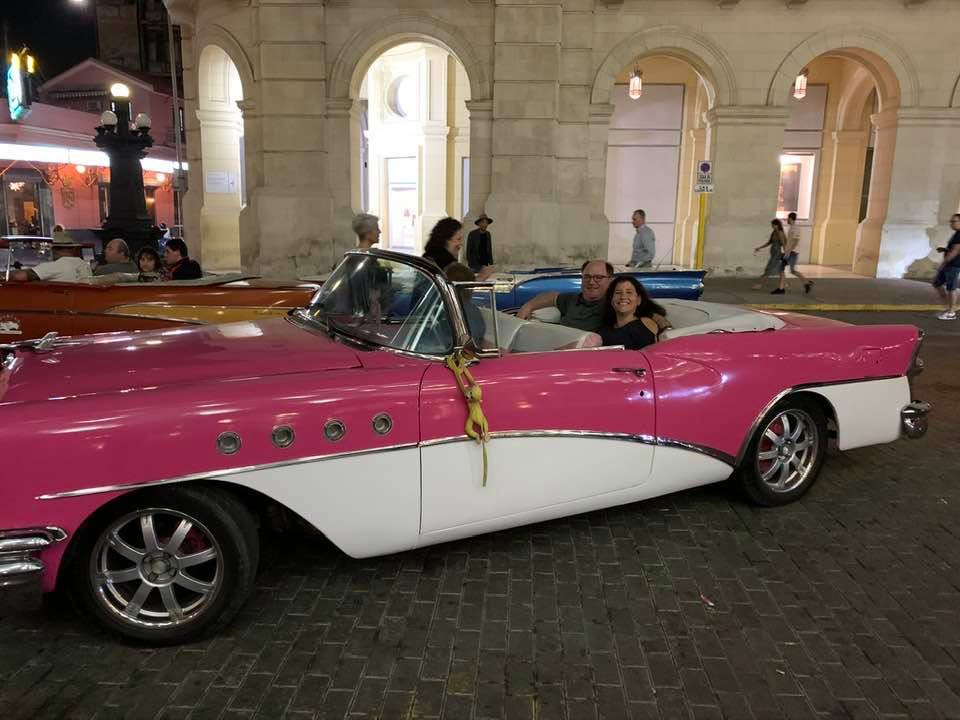 “Just so you know, I’m going to be quoting ‘Godfather II’ for the whole trip,” I said to a roomful of our traveling companions, as well as numerous times to my wife, prior to our visit to Cuba. An indication of my American solipsism, along with my tendency to make absolutely everything about movies? Yes and yes.
“Just so you know, I’m going to be quoting ‘Godfather II’ for the whole trip,” I said to a roomful of our traveling companions, as well as numerous times to my wife, prior to our visit to Cuba. An indication of my American solipsism, along with my tendency to make absolutely everything about movies? Yes and yes.
Nevertheless, in the seven days we spent in Cuba, I took in a lot more, about history, about socialism, and about the way national myths are constructed. Quite an illuminating journey, and one that I really hope Americans are going to be continue to be able to take.
My wife and I traveled to Cuba as part of a delegation of around 30, mostly associated with our synagogue, Temple Sholom in Broomall, although not everyone on the trip was a member. The purpose of our trip was to meet with and deliver aid to the small Jewish community in Cuba, and we all traveled on education/religious visas. I also did some journalism on the trip, but the Cuban government didn’t know about that.
We visited Havana, Santa Clara, Trinidad, and Cienfuegos, before returning to Havana at the end. I wrote for the Jewish Telegraphic Agency about my interactions with the Jewish community in Cuba, and their struggles in obtaining traditional Jewish foods, here. I also wrote for AppleInsider about the country’s nascent Apple subculture. This post is for the rest of my observations from the trip, that didn’t make it into the other pieces.
And yes, I took the advice of this piece, listing cliches to avoid while reporting on Cuba. In none of my writing from the trip will you see references to Cuba being “frozen in time,” a “forbidden island,” or to expressing that I’m glad I got to see Cuba “before it changes.” I also went places besides Havana.
On the trip, we visited the small Jewish community, who we visited in five different places on the island. There aren’t many of them, they don’t have rabbis, the population is aging, and (per the JTA link above) they can’t even get challah or bagels. But they’re keeping up hope, and are very thankful to have American visitors.
The Jews in Cuba, virtually unanimously, say they’re not worried about anti-Semitism in Cuba, but very much worried about it in the United States. They’re also very Zionist, and one staffer at the big synagogue in Havana was even wearing a Mossad t-shirt.
However, they’re very much not fans of Donald Trump, something they had in common with just about everybody on our trip.
About a half dozen times over the course of the year between our booking the trip and actually leaving, the Trump Administration announced new travel restrictions to Cuba, although thankfully none of them affected our trip.
You probably know some version of the history. Cuba was, and is, a communist country that was allied with the Soviet Union during the Cold War. The U.S., for all that time and ever since, has held an embargo in place preventing goods from reaching the island. The idea is that strain from the embargo will force Cuba to overthrow their government, but 60 years on, that hasn’t happened and shows no signs of doing so any time in the future.
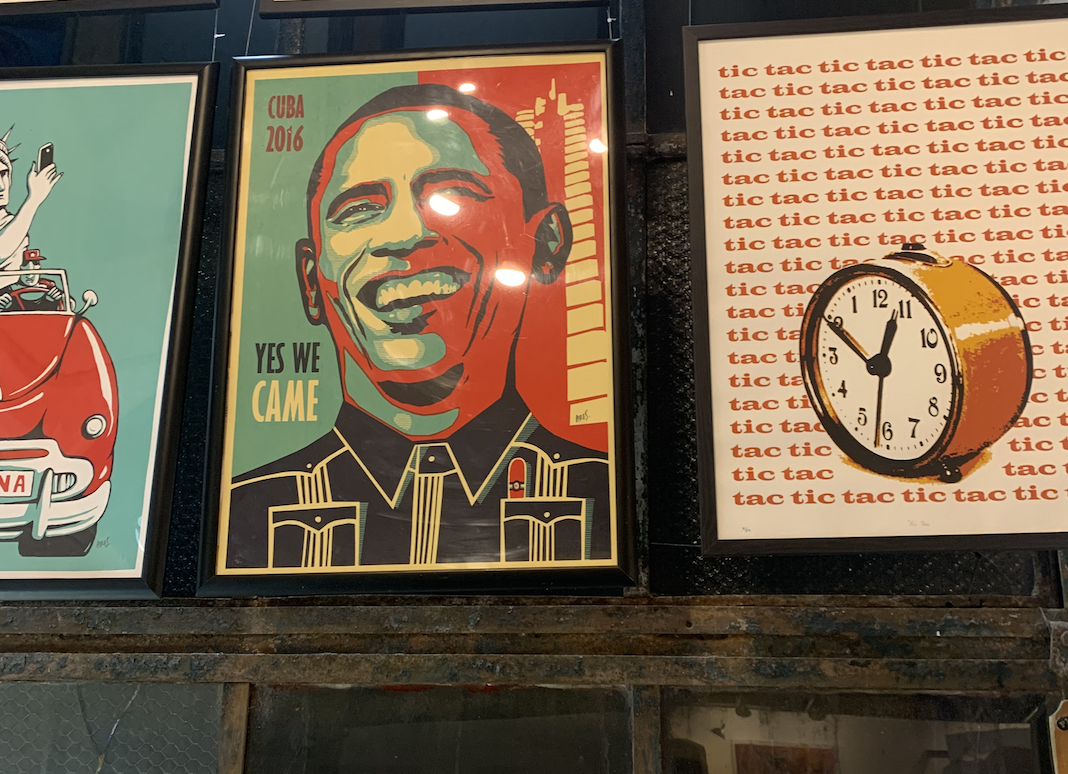
President Barack Obama, in 2015, normalized trade relations with Cuba, even visiting the country the following year. But the Trump Administration has since reversed some of the Obama-era changes. Not all though- Cuban rum and cigars are still allowed into the country, which I’m guessing came due to pressure from various Trump cronies.
Where does this all leave Cuba? The nation now finds itself dependent on income from tourists, both the dwindling amount from the U.S. and those from other countries. Therefore, Cuba ends up with essentially a bifurcated society in which tourists spend money and live like kings, while the natives live on rations and other scraps. Tourists even use a different currency (“CUCs”) than Cuban citizens.
Yet even in a country with no democracy and not much freedom, there is a great deal of hustle. For example: We visited the Cohiba cigar factory in Havana. We were told that while workers at the factory are paid a negligible daily stipend, every employee, per longstanding tradition, gets five cigars a day. Which they then, of course, sell.
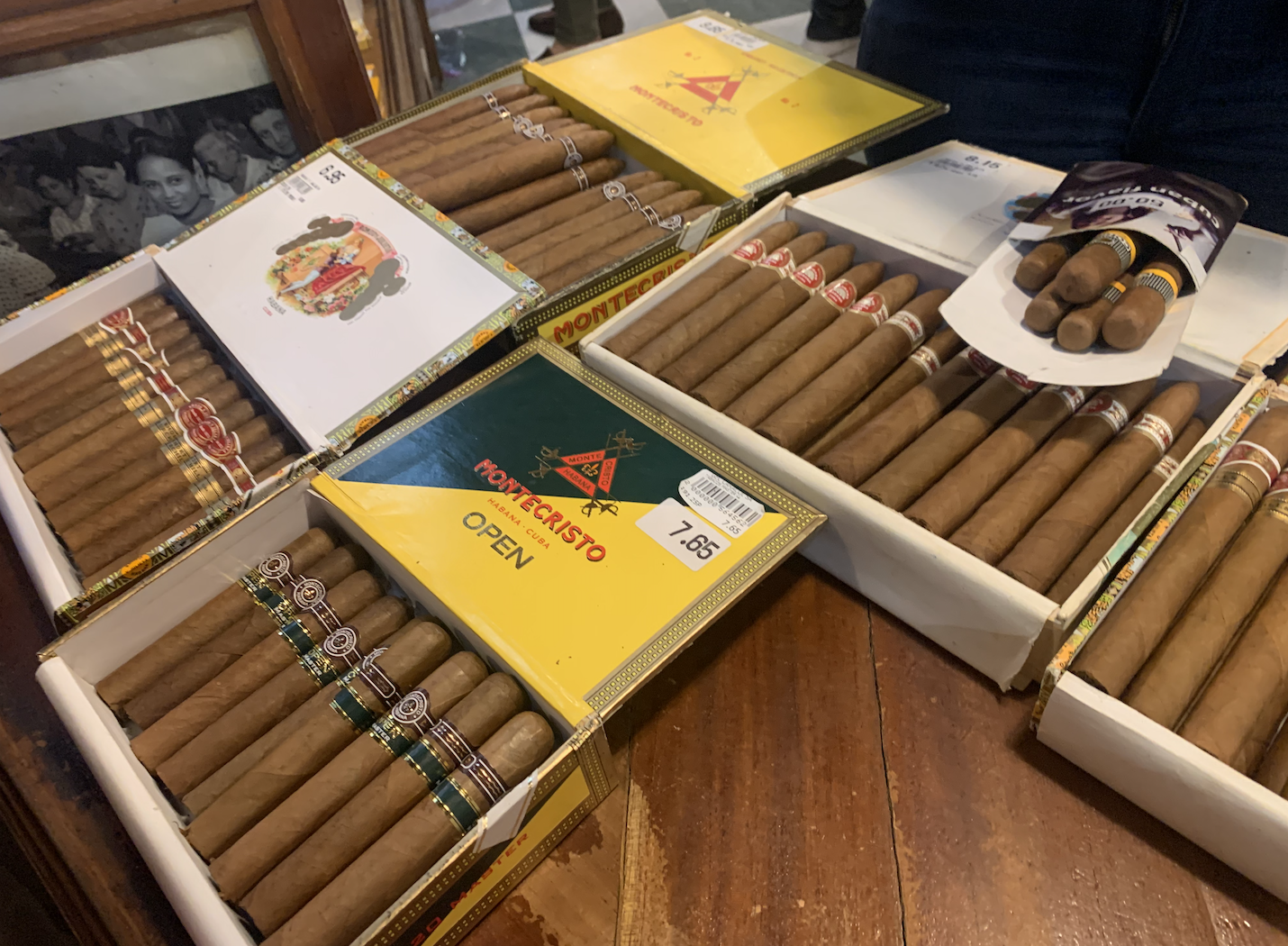
Have a cigar
From what I saw of Cuba, it certainly didn’t make me wish for America to turn to that specific strand of socialism. Then again, I don’t believe that Bernie Sanders, or even those to the left of him, are seeking to turn America into Cuba. Denmark, maybe.
The country, meanwhile, is festooned with iconography of Fidel Castro and Che Guevara. At the bookstores, every book is about them. Makes one feel kind of bad for the current First Secretary of the Communist Party of Cuba, Raul Castro, whose picture is absolutely nowhere. Meanwhile, The current president is Miguel Díaz-Canel, but his name is rarely mentioned, there are no pictures of him anywhere, and I just had to look up his name because I didn’t remember it.
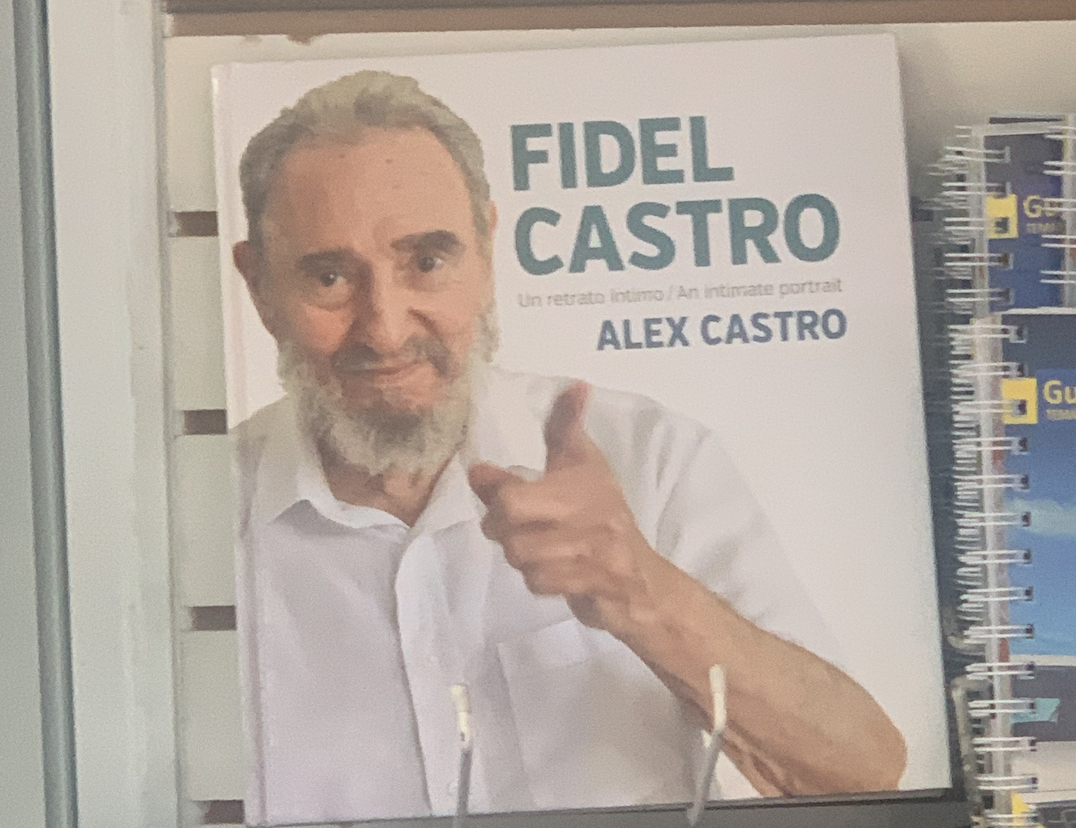
An incongruously funny picture of Fidel Castro.
Yet ironically, the Fidel Castro/Donald Trump parallels are uncanny. Both have dictatorial and authoritarian tendencies, disrespect for democracy, deep ties to the Russians, a weakness for giving key government jobs to relatives, and a tendency to deliver televised speeches that go on for hours. Also, both have inspired absolutely insane fan art. Trump is Castro, Castro is Trump.
Also, there’s a Rosenbergs memorial! I wasn’t sure if Fidel put that up because he thought they were innocent, or to thank them for being guilty. Probably the latter.
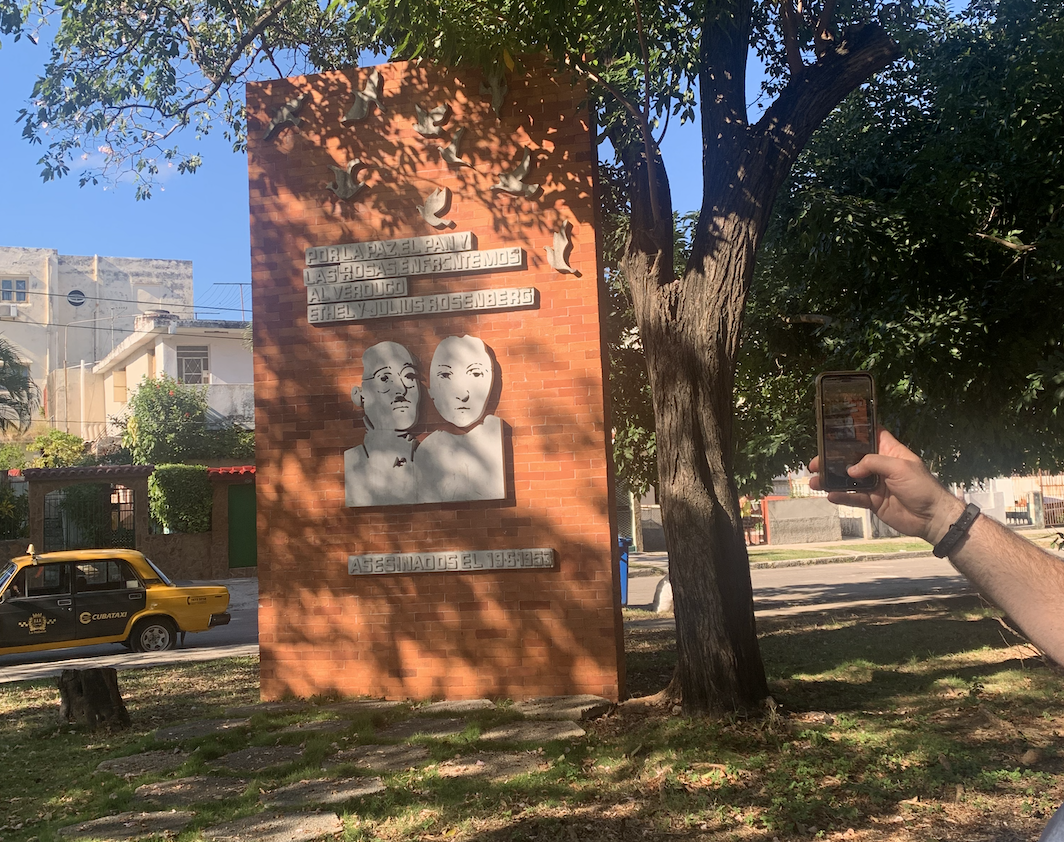
The other famous effect of the embargo? 1950s muscle cars, everywhere! Most of them incredibly well-preserved, especially in the paint jobs, although one we rode in had an empty space where the car radio used to be.
No, I didn’t quote The Godfather: Part II for the entire trip, but I did notice some familiar things. Meyer Lansky, the real-life Hyman Roth, built the Riviera, the Havana hotel that was next to ours. “And there isn’t even a plaque, or a signpost or a statue of him in that town!”
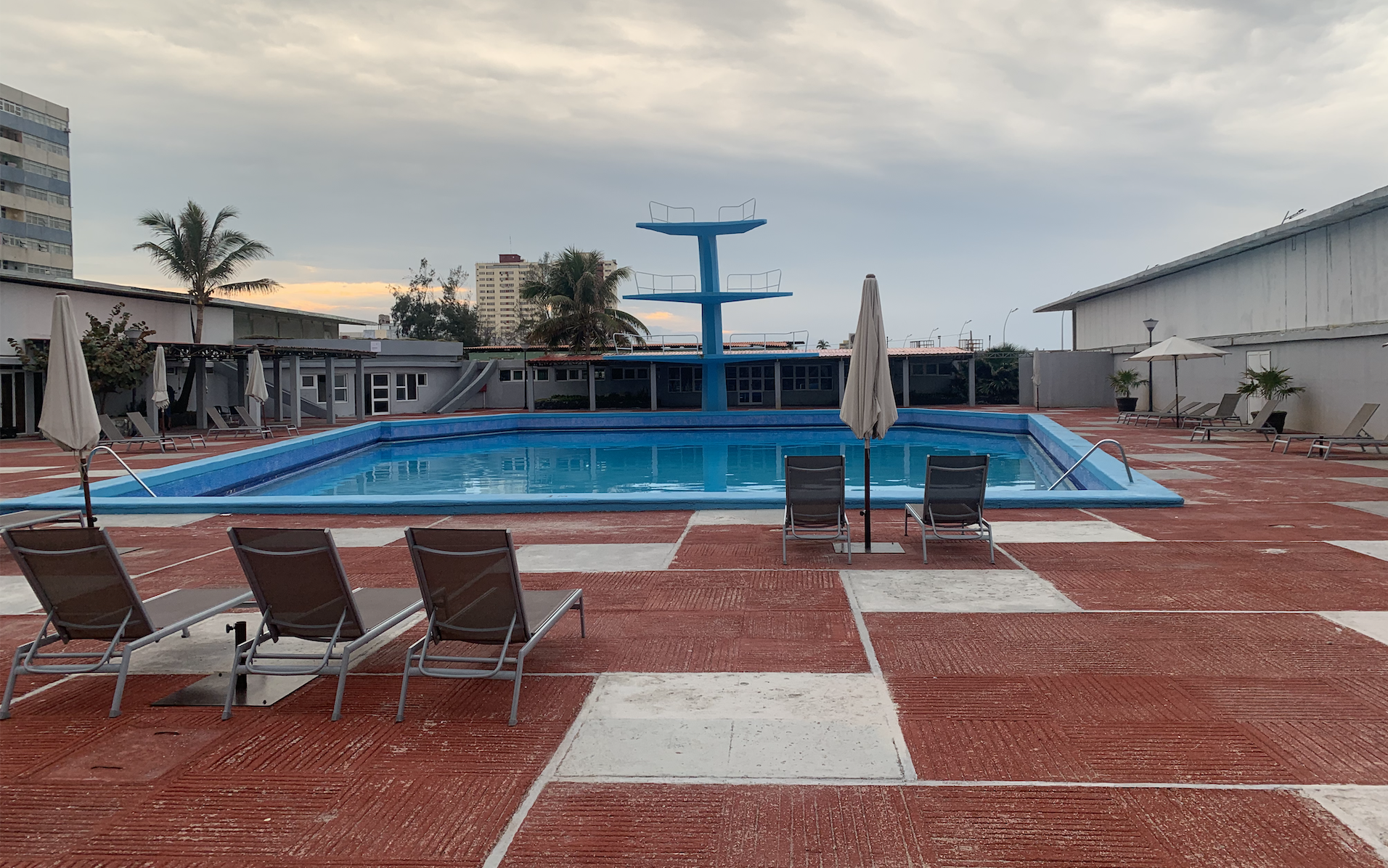
We also visited the Hotel Nacionale, another pre-revolution mob stronghold, which includes a special room featuring pictures of all the dignitaries who have visited the place over the years. It’s an eclectic mix of athletes, entertainers, and bloodthirsty dictators. It’s the only place I’ve ever seen the pictures of Bashar al-Assad and Wade Boggs side by side.
No, the Superman Show doesn’t exist, and hasn’t since the revolution. But “Superman” was a real guy, and this piece from 2015 by Mitch Moxley, which looked into his mysterious backstory, is a masterpiece of international reporting.
Speaking of movies, only a handful of Hollywood films were shot in Havana during the Obama-era thaw. One of them? That’s right, Fast & Furious 8. Our hotel was right near the spot where Vin Diesel’s car went into the ocean:
On the entire trip, I saw only one movie theater, and it appeared to be closed. Yet despite that, and the embargo, every Cuban I met seemed to have nearly encyclopedic knowledge of Hollywood movies. The talented film critic Monica Castillo, a couple of years ago, visited some of the island’s theaters.
Also, I saw Steven Spielberg’s picture all over the place. That might be because we went to a lot of Jewish places, and he must have gone to all of them, too
Yes, we visited Ernest Hemingway’s old estate, including his pool, where Ava Gardner used to swim nude:

Throughout the trip, our tour guide gave us the government-approved version of history, complete with some tale tales about “miracle medical cures” that its doctors have developed (other countries do this too, Israel especially.) She would go on to imply that the microphone she was using was bugged by the government. Much of the trip brought to mind Yakov Smirnoff’s old joke: “In America, you can say whatever thing you want, about Reagan. And in Soviet Union, you can say whatever thing you want, about Reagan.”
The Internet? We were able to get it in our hotels only, although I’m told for actual Cubans, access is unreliable, censored and incomplete.
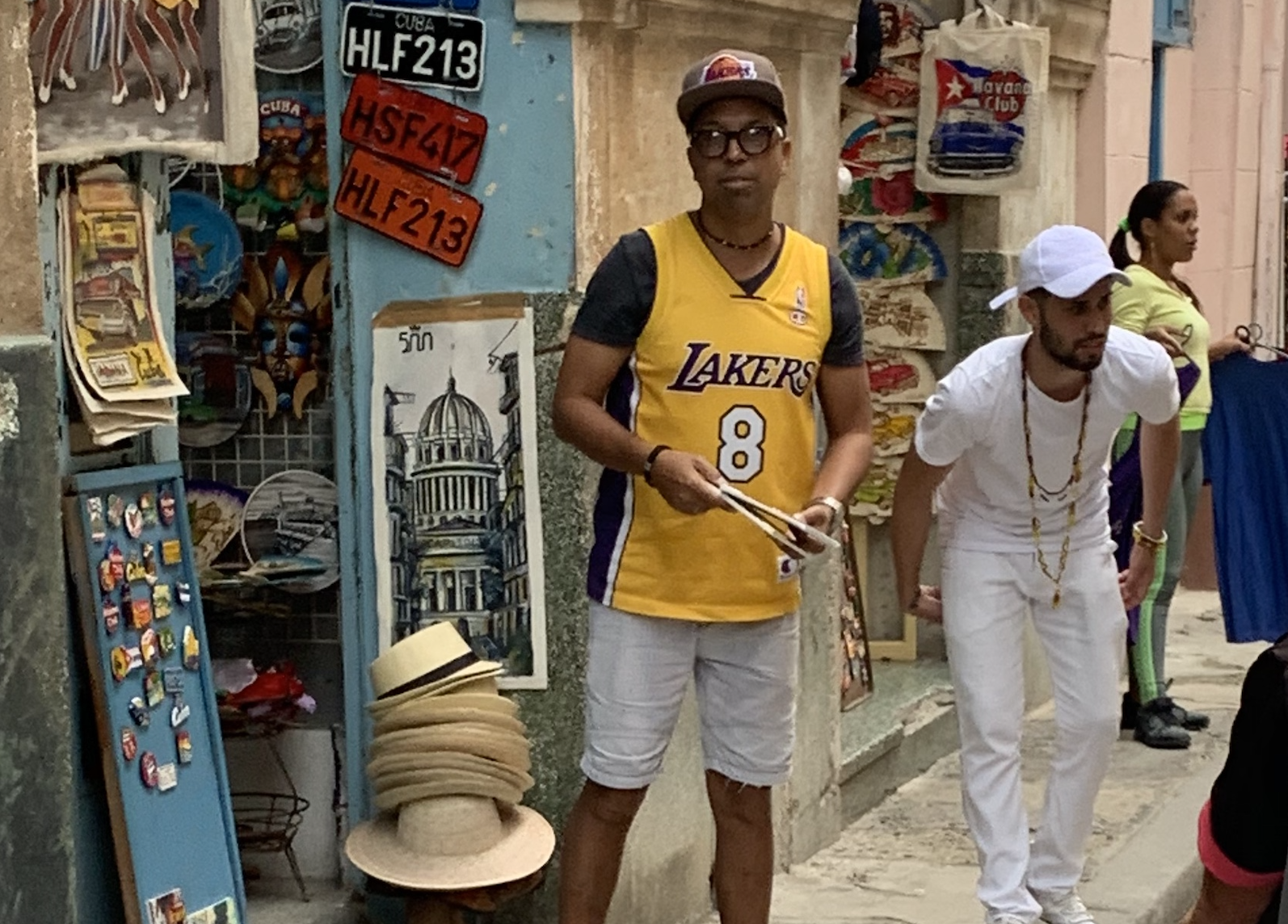
A street vendor in Havana sports a Kobe Bryant jersey, the day after the NBA legend’s death.
The first time we logged on, we got about 15 alerts about Kobe Bryant’s death. The next day, we learned there was an earthquake in Cuba, leading to fearful texts from just about everyone we know. The quake, alas, was on the other side of the country, and we didn’t feel it. Though we’d have been pretty screwed in an the event of a tsunami, since our hotel was a block from the water, protected by a tiny seawall that got overtopped more than once.
Also, as you may have heard, Cuba is a baseball country, and the home nation of numerous baseball players you probably know. We even visited a practicing baseball team. A deal was in the works to make it possible for Cuban baseball players to come to the major leagues without having to defect, but, you guessed it, Trump scuttled that as well.

It was interesting, though, that the Cuban national team shirts we saw for sale all had the names of players like Yasiel Puig, who have defected to the U.S. We got them for our kids, although I vetoed the purchase of an Aroldis Chapman jersey, for both domestic abuse and Yankee reasons.
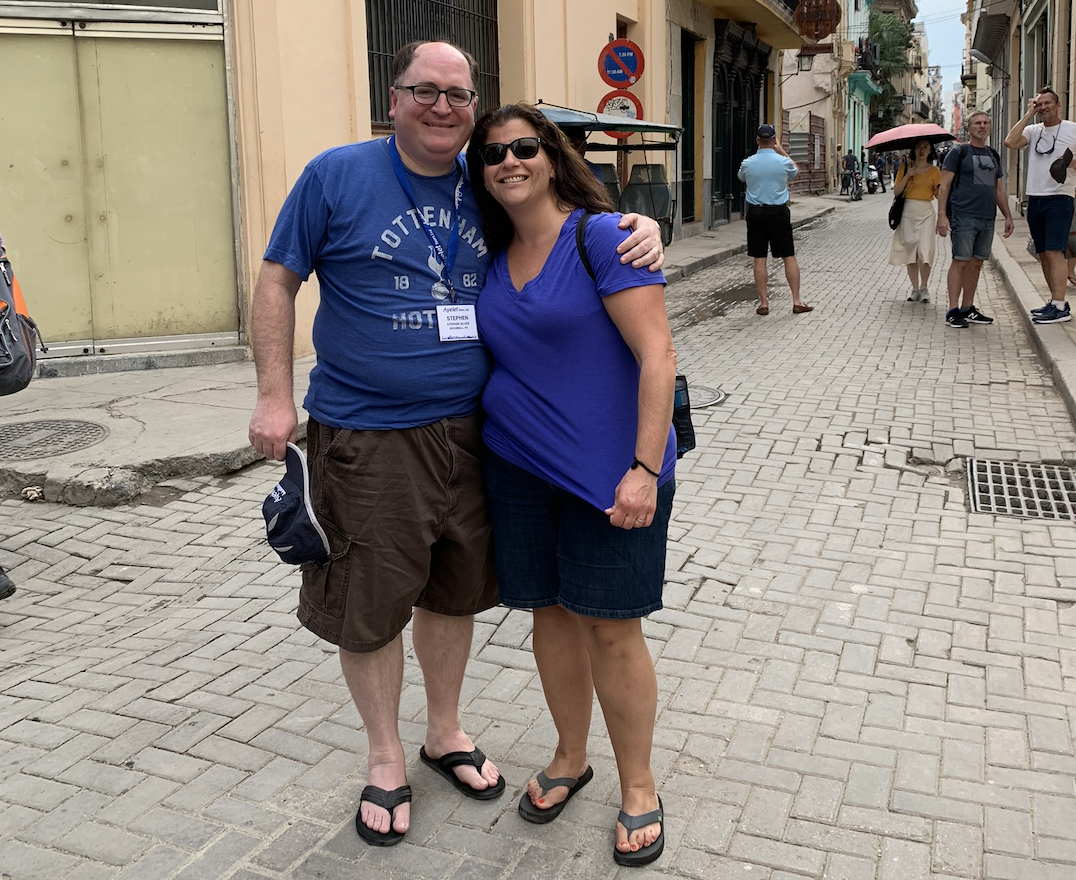
Cuba is one of those places that I’d known of for my entire life, and I’m glad I had the opportunity to visit it. I don’t know which direction things are going to go there, but I really hope for there to be more freedom for the people on the island, and more opportunities for Americans to visit them there.
Jeff Tweedy: Deep Cuts
So, back in February, I interviewed Wilco’s Jeff Tweedy for the Jewish Telegraphic Agency. It was one of my favorite interviews ever, and we talked about his music, his book, and his conversion to Judaism.
There was a ton in there that didn’t make it into the final interview, largely having to do with Tweedy’s parts in movies and TV shows, so I thought I’d put that right here, with some clips embedded:
Wilco’s music, while not quite a pop radio mainstay, is often featured in movies and even
in TV commercials; an episode of the Showtime show Billions last year even had two
characters engage in a heart-to-heart over the band’s album Yankee Hotel Foxtrot and what it meant for the doomed relationship between Tweedy and Jay Bennett:
There was even an acclaimed 2002 documentary about the band, I Am Trying To Break
Your Heart, and Tweedy had a guest-starring run on the sitcom Parks & Recreation,
which he said came about because lots of the show’s writers and performers were fans of him and the band.
Wilco – “Heavy Metal Drummer” (Jeff Tweedy’s son) from paranoidandroid on Vimeo.
“That’s where the flattering part ends because I think the character they were looking for was a washed-up Midwestern rock star, and they said I was the first person they thought of.”
One of the more memorable uses of Wilco in film was the scene in the 2014 film
Boyhood, in which the band’s song “Hate It Here” is playing in a car as Ethan Hawke’s character explains and praises the song to his teenaged son (Eller Cochrane.) While he likes the scene and the film, Tweedy says it’s not quite what it’s like when drives around his own sons.
“Ethan Hawke’s character in that scene was a lot more didactic towards his kid than I feel like I try to be with my kids, and it was very cool to be included in that movie… I think when Spencer and Sammy and I are in the car listening to music it’s much more as peers than me trying to interest them in what we’re listening to. I think what Ethan was doing in that scene was more teaching them how to listen deeply.”
Seeing his sons as peers goes beyond music singalongs, and Torah study. In the
documentary 17 years ago, Spencer is shown drumming to the rhythm of the Wilco song “Heavy Metal Drummer” and asking Tweedy to guess the song. The two released an album together in 2014, with Spencer playing drums.
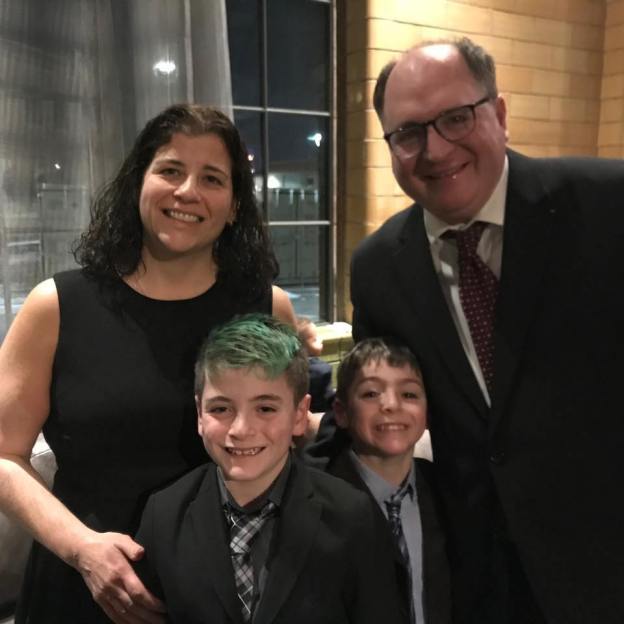
2018: A Writer’s Reflection
One of my goals, for most of my career as a professional writer, has been to get a place where if I have an idea for something to write, no matter the subject matter, I can always get it published somewhere, and get paid for it.
Here are the end of 2018, after a few twists and turns, I’m just about there.
I’m writing film reviews for Splice Today, Broad Street Review, and Philadelphia Weekly, in addition to essays on film and other subjects for those sites, Living Life Fearless, and Philly Voice, on top of the Film Scribes podcast and all of the other stuff I do with the Philadelphia Film Critics Circle.
I’ve been covering culture stuff with a local angle for Philly Voice, Philadelphia magazine and BSR, and writing other cultural stuff, with a Jewish angle, for the Jewish Telegraphic Agency, which puts my stuff in Jewish newspapers throughout the U.S. and Israel. For the first part of the year, until the site closed, I was the Pennsylvania correspondent for the political site 50 States of Blue.
Of late I’ve been contributing news pieces for Inquisitr, on a wide variety of topics, and I spent a good part of the year on staff with AppleInsider, and I still contribute there, both the Apple crime blotter column and other features. I also wrote sports-related pieces for both NBC Sports Philadelphia and Philly Front Office, and my work appeared this year at Backstage Magazine, JMore Baltimore, Bullz-eye, Shareblue, and the Brandeis University alumni magazine.
If you know anything about media, you know that the environment is more difficult than ever, including on one topic (film) that’s my big specialty. So I owe a big thank you to my editors, and to everyone who’s gone out of their way to read my stuff this year. Your support is very much appreciated.
What’s to come in 2019? I hope to continue what I’ve been doing, add more of it, and maybe finally get going on one of my various book ideas.
I normally share my “Big List,” of all of the movies I saw this year, on December 31, but in lieu of that this year I share my Letterboxd list of all of the 2018 movies I saw in 2018. There were 324, a new personal record. My top and bottom ten list article are here at Splice Today, and you can read all of my movie reviews at my Rotten Tomatoes page.
And finally, here are my 20 favorite things I wrote this year:
1. #1 on the list, there’s zero doubt: After the Eagles won the Super Bowl, I talked to Joseph Wylen, my then-93-year-old grandfather-in-law, about his lifelong Eagles love for PhillyVoice; he passed away less than three months late.
2. Just last week, JTA published my piece filling in the backstory of that Frank Sinatra-owned yarmulke that was auctioned off by Sotheby’s in early December- it dates back to a Jewish day school fundraiser in Margate in 1981.
3. I wrote an investigative piece, for AppleInsider, about Paul Manafort and his iCloud account.
4. For Broad Street Review, in October, I looked at whether or not Philadelphia is still a movie town.
5. I wrote for Living Life Fearless about why Twin Peaks fandom is the best fandom.
6. For Splice Today, I looked at why Trump isn’t really inspired by the Mafia, but rather the fictitious versions of the mafia.
7. Also for JTA- I visited a pickle festival, and looked into whether pickles should still be considered a Jewish food.
8. My favorite of many pieces I enjoyed doing for 50 States of Blue- looking back at the time, in 2001, when new Trump economic adviser Larry Kudlow wrote that adulterers have no place in public life.
9. Another 50 States one, looking at the political aspects of the Philadelphia Eagles’ Super Bowl victory:
10. I interviewed the Chapo Trap House crew for Philly Voice.
11. Also at Philly Voice: Looking back at Anthony Bourdain’s visit to Philadelphia, following his death
12. My favorite negative movie review of the year was of Gotti, for Broad Street Review.
13. I wrote for Philadelphia magazine about the unfortunate Philly election subplot on This is Us.
14. I wrote for the Brandeis alumni magazine about the 50th anniversary of the Transitional Year Program, and got to talk to my old professor Jerry Cohen.
15. For Philadelphia Weekly, I wrote about the Gosnell movie, which was the only review I wrote this year that resulted in the film’s director yelling at me on Twitter.
16. For PhillyVoice, I covered John Waters’ speech at Penn.
17. For Inquisitr, I looked at that Jerry Falwell pool boy story that we all wish was true but probably wasn’t:
18. For LLF, looking at the complexities of the Dan Schneider story.
19. For Philly Front Office, I covered a Baseball Prospectus event at the Phillies’ stadium.
20. And for AppleInsider, I looked at the Apple implications of John Carreyrou’s great Theranos book.
Happy new year everyone, and thanks for reading!
Do You Wish to Subscribe to My Newsletter?
Because you can, right here!
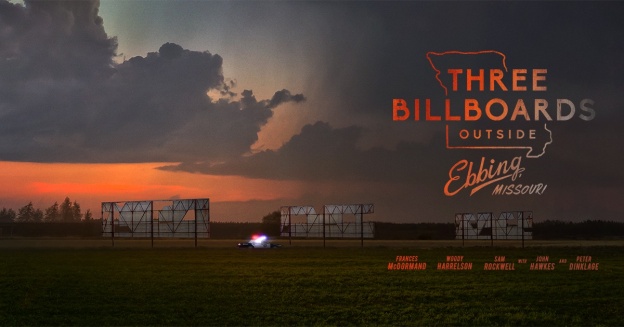
The Big List 2017: Ranking Every Movie I Saw This Year
So this year I saw 240 movies, which were released in 2017 that I saw in 2017. This breaks my record from last year by a significant margin, for a few reasons: I had better access this year to both screenings and screeners, due in part to the advent of the Philadelphia Film Critics Circle and the Film Scribes podcast. I’m also writing in more places this year.
Also, my friends in the film publicist world, both the local Allied reps and various national folks, went the extra mile this year, which is greatly appreciated. And I’d also liked to thank the Online Film Critics Society governing council, especially Dewey Singleton, for really coming through with delivering better access this year for OFCS members.
For the purposes of this list I’m including official, Oscar-eligible 2017 releases, as well as films I saw at film festivals that do not have a specific release date in any other year, whether 2016 or 2018 (so that omits Chappaquiddick and Thoroughbreds, which you can look for on next year’s list.) You can read the 2016 version of the list here, 2015 here,
As always, you can read all of my reviews at Rotten Tomatoes and on my Splice Today author page, and you can read my expanded Top Ten list article here, and my look at the year’s top documentaries here. You can also listen to and subscribe to the podcast, and come to our event at the Prince Theater on January 9.
Thank you all, once again, for reading my reviews this year and listening to the podcast. Even after more than 20 years, I still can’t believe that I actually get to do this.
Without further ado..
The Big List 2017:
- Three Billboards Outside Ebbing, Missouri
- Get Out
- The Florida Project
- Lady Bird
- Call Me By Your Name
- Dawson City Frozen Time
- Coco
- The Post
- The Shape of Water
- Baby Driver
- Princess Cyd
- Star Wars: The Last Jedi
- Wonderstruck
- Marjorie Prime
- Lucky
- Let’s Play Two
- Wonder Woman
- The Disaster Artist
- Norman: The Moderate Rise and Tragic Fall of a New York Fixer
- mother!
- Mudbound
- Icarus
- Risk
- Logan Lucky
- Wormwood
- Wind River
- Alaska is a Drag
- Long Strange Trip
- The Breadwinner
- Lady Macbeth
- Get Me Roger Stone
- The Work
- Jane
- Obit.
- BPM (Beats Per Minute)
- Columbus
- Battle of the Sexes
- The Big Sick
- The Beguiled
- It
- I, Tonya
- Spider-man: Homecoming
- Thor: Ragnarok
- Dunkirk
- American Made
- The Meyerowitz Stories: New and Selected
- Last Flag Flying
- A Ghost Story
- Blade Runner 2049
- The Lego Batman Movie
- The Greatest Showman
- Atomic Blonde
- Detroit
- The Square
- Nocturama
- Faces Places
- One of Us
- Quest
- I Called Him Morgan
- Colossal
- The Little Hours
- Five Came Back
- A Gray State
- Ex Libres The New York Public Library
- Jim and Andy: The Great Beyond
- Long Shot
- Abacus: Small Enough to Jail
- May It Last: A Portrait of the Avett Brothers
- All The Queen’s Horses
- Oklahoma City
- Jeremiah Tower: The Last Magnificent
- The Force
- Darkest Hour
- A Quiet Passion
- Girls Trip
- Professor Marston and the Wonder Women
- The Killing of a Sacred Deer
- Logan
- John Wick Chapter 2
- Okja
- Their Finest
- The Hero
- Beauty and the Beast
- The Blackcoat’s Daughter
- The Hitman’s Bodyguard
- Brad’s Status
- Dean
- Marshall
- Menashe
- First They Killed My Father
- Rough Night
- Strong Island
- Gilbert
- Step
- LA 92
- Joan Didion: The Center Will Not Hold
- 11/8/16
- Loving Vincent
- Last Men in Aleppo
- City of Ghosts
- Beauty and the Dogs
- The Wall
- Human Flow
- Gook
- Brigsby Bear
- The Eagles of Death Metal: Nos Amis
- The Ballad of Lefty Brown
- At the Drive In
- Let It Fall: Los Angeles, 1982-1992
- Bombshell: The Hedy Lamarr Story
- Tickling Giants
- Thelma
- Gifted
- Gerald’s Game
- Graduation
- Personal Shopper
- All the Money in the World
- Victoria & Abdul
- Brawl in Cell Block 99
- Murder on the Orient Express
- Ingrid Goes West
- After the Storm
- The Last Laugh
- Dina
- Gaga: Five Foot Two
- AlphaGo
- Cries From Syria
- The Fate of the Furious
- Crown Heights
- The Problem With Apu
- My Entire High School Sinking Into the Sea
- All These Sleepless Nights
- The Women’s Balcony
- The Man Who Invented Christmas
- Megan Leavey
- The Lost City of Z
- It Comes at Night
- Contemporary Color
- Kedi
- In the Fade
- The Death and Life of Marsha P. Johnson
- California Typewriter
- Philadelphia and the Invention of Movies
- Disgraced
- Whitney: Can I Be Me
- Elian
- Ferdinand
- Karl Marx City
- Alien: Covenant
- Roman J. Israel, Esq.
- Phantom Thread
- Molly’s Game
- I Love You, Daddy
- Wait For Your Laugh
- The Lovers
- The Lure
- The Incredible Jessica James
- Captain Underpants: The First Epic Movie
- Beatriz at Dinner
- Wonder Wheel
- Mobile Homes
- The Death of Louis XIV
- Kong: Skull Island
- Guardians of the Galaxy Vol. 2
- Goon: Last of the Enforcers
- England is Mine
- Kingsman: The Golden Circle
- A Bad Moms Christmas
- A Cure For Wellness
- Raw
- Donald Cried
- Land of Mine
- Landline
- Bright Lights: Carrie Fisher and Debbie Reynolds
- The Final Year
- Cars 3
- Boss Baby
- Justice League
- Chasing Coral
- The Dinner
- Patti Cake$
- Carrie Pilby
- Whose Streets?
- Film Stars Don’t Die in Liverpool
- I Don’t Feel At Home in this World Anymore
- Mark Felt: The Man Who Brought Down the White House
- Holy Air
- Scaffolding
- Bloody Milk
- Everything, Everything
- Good Time
- Power Rangers
- Lemon
- Valerian and the City of a Thousand Planets
- Lost in Paris
- The Zookeeper’s Wife
- Voyeur
- Nobody Speak: Trials of a Free Press
- Rebel in the Rye
- The Human Surge
- Beware the Slenderman
- To the Bone
- Person to Person
- All Eyez on Me
- T2: Trainspotting
- War Machine
- King Arthur: Legend of the Sword
- Despicable Me 3
- The Last Word
- The Bad Batch
- Sister of Mine
- The Glass Castle
- The Great Wall
- The Hatred
- Wilson
- Snatched
- Split
- Song to Song
- Free Fire
- Sweet Country
- Diary of a Wimpy Kid: The Long Haul
- CHIPS
- Pitch Perfect 3
- Fun Mom Dinner
- Most Beautiful Island
- Table 19
- The House
- Going in Style
- The Space Between Us
- Goodbye, Christopher Robin
- The Circle
- Downsizing
- Baywatch
- The Mummy
- Fifty Shades Darker
- Bright
- Suburbicon
- The Dark Tower
- The Only Living Boy in New York
- Fist Fight
Did not see (reputedly good): Hostiles, Stronger, A Fantastic Woman, Foxtrot, Citizen Jane: Battle For the City, Jumanji: Welcome to the Jungle, Rat Film, LBJ
Did not see (reputedly bad): Transformers: The Last Knight, Pirates of the Caribbean: Dead Men Tell No Tales, The Emoji Movie, The Book of Henry, The Snowman, Daddy’s Home 2,
My 20 Favorite Things I Wrote in 2017
2017 was quite a year for me, as a writer. I’ve been full-time freelance for seven of the 12 months, and in that time I’ve gotten to do a lot of stuff I’ve been talking about doing for years, including starting a film critics group and podcast, and even taking steps towards putting together a book proposal. I’ve also expanding the outlets I’m writing for, with hopefully more to come in the new year. Here are some of my favorites:
- “The Many Kinds of Baseball Families: A League of Their Own at 25” (RogerEbert.com, June 12.) Roger Ebert is a formative influence on me as a writer and I probably wouldn’t be a film critic today if not for him, so it was a thrill to finally have my work on the site that bears his name- especially while writing about a film that’s always meant a lot to me.
- “Oldies.com: The Story Behind That Warehouse” (PhillyVoice.com, August 9.) Most people who live in the Philadelphia suburbs know the Oldies.com warehouse, but most don’t know the story behind it. So I looked into it and discovered the amazing, 60-year story that starts with a rock single from the 1960s.
- “Big Screen Blues” (Broad Street Review, June 5.) I’ve been complaining for a long time that there isn’t a great movie theater, or enough movie screens, in Philadelphia, so I wrote it.
- “Political Correctness is Not Killing Comedy” (Screen Rant, October 4.) Much as I hate to disagree with Mel Brooks, I once again flogged a longtime hobby horse of mine here.
- “Bruce Prichard, Wrestling’s Brother Love, Brings Show to Philly” (PhillyVoice.com, July 24.) I got to talk to the guy who played Brother Love in WWE- and now hosts one of the world’s best podcasts- before his recent live show.
- ‘Fist Fight is Ugly and Sinister” (Splice Today, February 17.) I wrote a lot of movie reviews this year, but this one, of the year’s worst movies, 8was probably the angriest.
- “Is the Mystery of Ga-ga, Everyone’s Favorite Summer Camp Game, Finally Solved?” (Tablet, August 2.) A year after I looked into the summer camp sport’s beginnings, I heard from a guy who says he invented the game himself.
- “Markelle Fultz and the Catch-22 of Playing Hurt” (NBC Sports Philadelphia, October 25.) I wrote about how insane it is to vilify athletes for not wanting to play hurt.
- “The Final Fall of Pete Rose” (Splice Today, August 11.) I wrote about how Jim Gray was right: Pete Rose has been his own worst enemy, and continues to be.
- “The Documentaries of 2017: When Best Laid Plans Go Beautifully Awry” (Living Life Fearless, December 6.) I looked into why most of the year’s best documentaries ended up much differently from how they were originally planned.
- “How the NFL Anthem Controversy (Mostly) Missed Pennsylvania” (50 States of Blue, December 8.) My first big essay for the political site at which I’m now Pennsylvania correspondent.
- “Where Do the Muppets Go From Here?” (Screen Rant, July 27.) After the firing of Steve Whitmire as Kermit, I looked at what comes next for the Muppets franchise.
- “Johnny From Dirty Dancing Pops the Question to State Mate” (Philly Voice, May 23.) My wife and I went to see the “Dirty Dancing” stage musical for our 10th anniversary- and after show, the actor playing Johnny proposed to the actress playing Penny . She said yes, and I interviewed both of them a few days later.
- “The Case For Casting Kyle MacLachlan” (Living Life Fearless, October 6.) I made the case why “Twin Peaks: The Return” should mean renewed stardom for its leading man.
- “Philly Geek Awards Celebrate Nerds Far and Wide” (PhillyVoice.com, August 28.) I was happy to cover the Philly Geek Awards for the first time, as it honored everyone from hackers to doctors to political activists.
- “Has Game of Thrones Been Foreshadowing Daenerys’ Death?” (Screen Rant, September 11.) I tried my hand at Game of Thrones speculation, in pointing out a whole bunch of random references to a single arrow striking Khaleesi.
- “The Chappaquiddick Film Couldn’t be More Timely- So Why the Delay?” (Living Life Fearless, November 28.) I covered the Philadelphia Film Festival for four different publications, and this one dealt with a film that hasn’t been released it- so I wrote about why.
- “Three Billboards, Lady Bird Among the Best of the Philadelphia Film Festival” (Splice Today, October 31.) I also looked at some of the best films of the festival (and the year.)
- “SuiteWorld 2017 Highlights Part 1 and Part 2 (Andersonfrank.com, April.) At my former day job, I returned to my CES roots and covered a big tech event in Las Vegas.
- “Lessons From the Wonder Woman Wars” (Screen Rant, June 30.) I look at the many controversies- feminist, political, Israeli- related to the release of Wonder Woman.
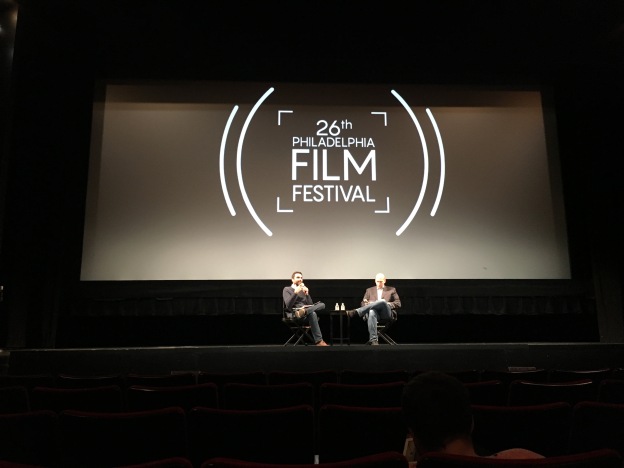
A Podcast is Born
I’ve been talking about doing a movie podcast for what seems like years, probably because it has been years. We were actually on the verge of launching one, with equipment purchased and everything, when TechnologyTell closed back in the summer of 2015.
My friend Rich Heimlich and I had been talking about launching both a Philadelphia film critics group and a podcast for years, and now, happily, we’ve launched both. You can check out the first three episodes of the Film Scribes podcast- the first two of which I’m in, right here, and you can also subscribe on iTunes, and even leave us a nice review if you so choose. We record every Sunday at The Olde Bar, in the old Bookbinders on Walnut Street in Old City, and it’s usually online on Tuesdays.
On the first episode we previewed the recently completed Philadelphia Film Festival, and on the third my colleagues recapped it, and I’m happy to have spread my coverage of the fest over three different outlets
- I reviewed I, Tonya and The Florida Project at Broad Street Review.
- I reviewed three of the festival’s best films, Three Billboards Outside Ebbing, Missouri, Lady Bird, and Alaska is a Drag, at Splice Today.
- And I wrote about the award given to Bruce Willis by M. Night Shyamalan, at Philly Voice.
- On the day of the Willis event, I was happy to present a discussion of the movie Denial at Temple Sinai in Dresher, PA, as part of Hot Dog and a Movie Night (We thought about calling it “Hot Dogs and Holocaust Denial,” but…) Anyway, if you’re at a synagogue or another institution and would like to host me for such an event, get in touch with me.
- As always, you can read all of my movie reviews at my Rotten Tomatoes page.
- In addition to that, I recently took on a new part-time role as Northeast Regional Casting Reporter for Backstage.com. If you have any movie, TV or theater casting notices in Boston, Philadelphia, Pittsburgh, Baltimore, Washington, Cleveland or Cincinnati, let me know.
- I’ve got another new gig coming up that I can’t talk about yet, but soon. I also had one book project I was working on, stalled out with it, and started working on another one. More on that later.
A few other recent writings of mine:
- I was interviewed by my friend Pete Croatto for The Writer magazine about my process for finding gigs. I talked to Pete for this a LONG time ago, but good to see it finally surface.
- At the website known as Living Life Fearless, I have written three essays: A defense of traditional movie-going, an argument for movies to cast Kyle MacLachlan, and an essay about The Meyerowitz Stories and the career of Noah Baumbach.
- I wrote an essay at Splice Today about the fraught topic of Harvey Weinstein and jokes.
- I wrote another essay for Screen Rant about why there’s a good chance Blazing Saddles could be made today. You can read my other Screen Rant stuff here.
- At Philly Voice, I looked at Philadelphia’s ever-more-crowded roster of comic-con events.
- I wrote for the newly-renamed NBC Sports Philadelphia about Markelle Fultz, and while it’s wrong to demand that athletes “play hurt”
And finally, speaking of which: I’m thinking about launching a Patreon-supported website, in which I would write, five days a week, columns about Philadelphia sports. Would you be interested in reading about this? Donating to it? If so, let me know.

